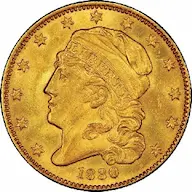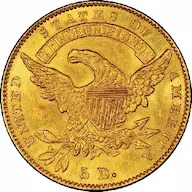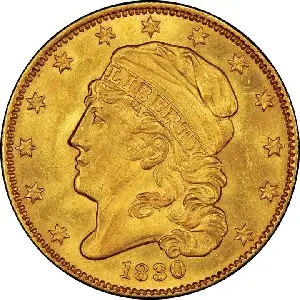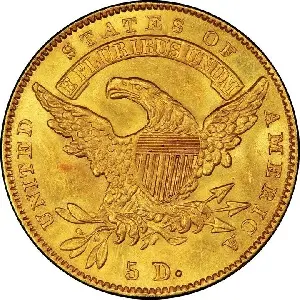1830 Capped Head $5 Half Eagle, Small 5D
The story of the 1830 Capped Head Small 5D $5 half eagle closely parallels that of 1830 Large 5D half eagle.
In 1813, John Reich modified his Capped Draped Bust half eagle to show Liberty’s enlarged head from the neck upward, and repositioned the stars, resulting in what collectors call the Capped Head type.(1)
The Capped Head half eagle remained in production through 1834 (skipping 1816 and 1817). Of the cumulative 1.39 million mintage of this series, less than 1750 examples are estimated to survive to this day. Stated another way, almost 99.9% of the original total is gone!(2)
Out of 34 major varieties in the Capped Head half eagles, 60% of the survivors are counted in the top five most numerous varieties. The remaining 40% are splintered among the remaining 29 varieties, some of which are uncollectible due to their extreme rarity.
The remarkably low survivorship of the Capped Head half eagles is fairly typical of early United States gold coins. Huge numbers of them were melted by international bullion profiteers. The root cause of their incentive can be traced back to the beginning of United States coin production.(3)
The Mint Act of 1792 established the U.S. Mint and regulated the issuance of coinage. The Act rigidly set the value of silver to gold at 15 to 1 in the United States. When Napoleon of France began his attempted conquest of Europe, the free market bi-metallic ratio in London and Paris rose to 15.5 to 1. Tensions between the United States and Europe eventually pushed the ratio to 16 to 1.
Under these circumstances, U.S. gold coins were worth more than their face value, if sold in Europe. Speculators purchased gold coinage in the U.S. at a rate of one ounce for 15 ounces of silver, exported it to Europe where it was melted down and sold for 16 ounces of silver in exchange for one ounce of gold. The silver returned to the U.S. and the cycle repeated itself.
As the 19th century rolled on, there were other wars and large discoveries of silver in Latin America that kept the world price of gold to silver hovering around 16:1, except for the U.S., where the ratio was stuck at 15:1.
Much of the Mint’s production of gold coinage, most notably the Capped Head half eagles, was intercepted by speculators and never had a chance to enter circulation. This scenario continued until 1834, when Congress authorized the reduction of gold weight in U.S. coinage. Only then did gold coinage circulate as intended within the nation’s interior.
Numismatic scholar John Dannreuther estimates only 30-40 examples remain today of the 1830 Small 5D variety. The Large 5D is a tad scarcer, with only 25-35 extant today.(4)
When the Capped Head half eagle is placed in the context of world history, it becomes clear why so few of them are available today for collectors. The enormous rise in value we’ve witnessed for so many of Capped Head half eagle dates, including both 1830 varieties, is based on solid numismatic fundamentals: very high demand vs. very small supply = consistent price escalation.
| Estimated survivors in all grades: 40 ?
The survivor estimate from researcher John Dannreuther. |
| PCGS Rarity Scale: 8.7 ?
The 'PCGS CoinFacts Rarity Scale' assesses the relative rarity of all U.S. coins, based on estimated surviving examples. The scale runs from 1.0 to 10.0. The higher the number, the rarer the coin.
Learn more at PCGS. |
| Search for the 1830 Capped Head $5 Half Eagle, Small 5D on eBay** |
Preview of eBay selection (like many Capped Head $5s, you seldom see one for sale):
 |
 |
| Trendline Avg = 20.63 | BETTER |
 |
 |
| Trendline Avg = 20.63 | BETTER |
Historic Value Trend Charts:
| Last updated 8-11-25 | Return to Key Date Coin List | |
| Compare to Common Date Coin of Same Type | ||
|
|
||
| Download Charts to Your Computer | ||
Sources
1. Bowers, Q. David. The History of United States Coinage. Los Angeles, CA: Bowers and Ruddy Galleries, Inc., 1979.
2. PCGS. Capped Bust $5.
3. Taxay, Don. The U.S. Mint and Coinage. New York, NY: Sanford J. Durst Numismatic Publications, 1966.
4. Heritage Auctions. 1830 $5 Small 5D. Sept 2022 Auction.
**Many very fine coin dealers sell on eBay. At any point in time, there may be over one million search results for United States coins. This includes quite a few of the recommendations on our Key Date Coin List.
If you’re thinking about purchasing a rare coin, eBay is certainly worth a look. For your convenience, the links from this site to eBay are coded to bring up only coins certified by PCGS and NGC.
As is always, always the case, never buy a valuable coin from a seller whose trustworthiness cannot be verified. Learn more about this at our chapter Best Places to Buy Coins, which also has a section on doing business on eBay.
In the interest of full disclosure, Rare Coins 101 receives a small commission anytime someone connects to eBay from this site and purchases something.
Coin images by Stack's Bowers Galleries.


